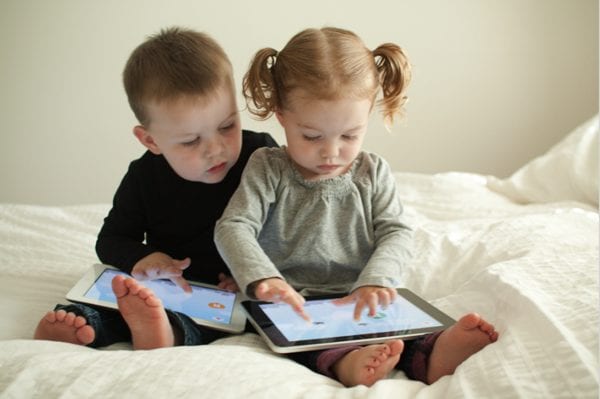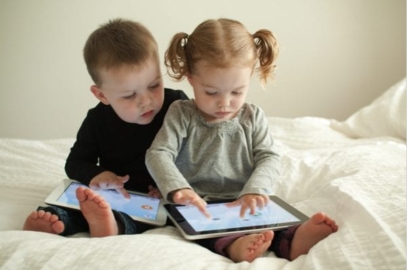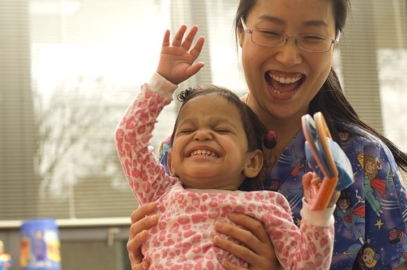February 25, 2019
Screen Time and Younger Kids
Patty Romanowski Bashe, MSEd., BCBA
It would be hard to imagine life today without our smartphones, laptops, and iPads. That eye-catching stream of information and entertainment the internet delivers with a click or a swipe is easy to love and hard to put down. Digital media has become an everyday part of most children’s lives, too, and not always in ways parents would wish. If your toddler tantrums when the iPad gets shut down, it’s time to reconsider screen time.
“Screen time” is shorthand for all the digital media time your child spends on television, computers, smart phones, and even the Smart Boards and other electronics at school. The role screen time plays in a child’s life depends on many things, such as how much access he has, how adults and others in his life interact with media, and what other activities occupy his time. We know that for most children—especially younger ones—a little bit goes a long way. And that includes even the “good” stuff: professionally developed educational programming and websites.
In the past several years, the American Academy of Pediatrics has issued numerous warnings and recommendations about kids and screen time. The take-home message for all of us is that “Media in all forms . . . can affect how children feel, learn, think, and behave.” Childhood is a critical time for social and emotional development, for learning to understand and communicate with others. Interaction and play in the “real world” offer opportunities for active learning that the mostly passive digital experience cannot provide. Too often, staring into a screen puts children in “a world of their own,” oblivious to what’s happening around them. For this reason, many of the guidelines stress the importance of adult involvement during screen time.
Another way to view digital media’s place in your child’s day is to ask two questions: How much time does screen time take? And what are the other things she can or should be doing instead? For most younger children, screen time takes up time that would otherwise be used in play or social interaction. This can lead to delays in language development, learning, and social skills. We also know that exposure to electronics can disrupt sleep for littler ones and steal hours of needed rest from older kids. Excessive screen time often replaces physical activity, a risk factor for childhood obesity. Keep in mind that these concerns apply to all media use. But there is a special warning about violent content. The research is in: viewing violence can be scary or confusing for younger children and can provide an inappropriate model for how to behave toward others.
Though digital media feels unavoidable, parents can and should set the terms. You are not being the “mean” parent or “depriving” your child of something it seems like everybody else is doing. When the American Academy of Pediatrics issued its first recommendations about children and electronic media, many parents found them overly restrictive and “unrealistic.” One important recommendation—that a parent or another adult should be present and involved during a younger child’s screen time—is often exactly the opposite of how many of us use our devices. Especially for younger kids, though, screen time should never be solo “me” time. There are many things younger kids can do on their own—resting, a certain amount of play, looking at books, doing puzzles. However, as we adults consider our own relationships with our electronics, actively defining the role screen time plays in your child’s day makes sense. You’ll be making today’s screen time worthwhile and helping set habits for the future.
- For children of all ages: programming, websites, and interactive games should be age-appropriate and of high quality. Especially while your child is developing language and social skills, click past “no name” kiddie programming designed only to hook and amuse. When in doubt, compare it to a clip from a professionally produced, acclaimed program like Daniel Tiger’s Neighborhood. Note that media designed to teach and nurture is appropriately paced, has a theme, teaches through repetition with numerous examples, and “speaks to” your child with respect and care. For older kids, be clear about your family’s values and promote the view that these apply online or onscreen, too. Other tips: avoid exposure to electronics one hour before bedtime (it can delay or disrupt sleep), don’t use digital media to calm or distract your child when upset (it interferes with learning to cope), and protect family time for meals, bed, homework, and just being together from electronic intrusion (turn it off).
- For children from birth to age two: Any digital media activity should involve an adult. Here the screen is just a part of the interaction and teaching that should occur, not the focus. Live video “chatting” with family is a good example of age-appropriate screen time.
- For children from eighteen to twenty-four months: Remain present with your child during all screen time. Children this age should not be engaging with media alone.
- For children two years to five years old: Continue being involved in your child’s screen time. Now that most children are attending day care or preschool, think of other activities that involve friends, physical activity, and experiences that promote interest and skill building in the real world: exploring, building, being a helper at home, reading, dancing, caring for a pet, to name just a few.
A great resource for finding digital content (games, apps, movies, programs) that’s right for your child and your family is Common Sense Media.






